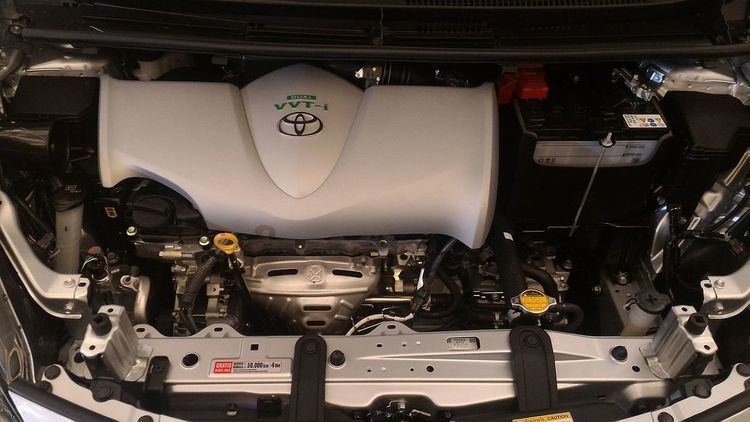 | ||
The Toyota NR engine family is series of small a inline four piston engines by Toyota, with capacities between 1.2 and 1.5 L.
Contents
Common features of this series
The NR series uses aluminum engine blocks and DOHC cylinder heads. It also uses multi-point or direct fuel injection and has four valves per cylinder. The 1NR, 2NR, 3NR, 4NR, 5NR, 6NR, and 7NR engines have Dual VVT-i standard and the 8NR engine has VVT-iW, enabling it to operate in the Otto cycle as well as a modified-Atkinson cycle to improve thermal efficiency.
1NR-FE
The 1NR-FE is a compact inline four piston engine featuring "Stop & Start" technology and Dual VVT-i. It was introduced into European market in late 2008 with the Yaris XP9F. Improved engine performance combined with low emissions and fuel consumption was the principal aim during its development.
Advanced engineering has been applied throughout the 1NR-FE engine. Toyota engineers streamlined the engine's intake channel, used computer simulation to optimise airflow, smoothened all surfaces for less turbulence and rounded off all angles and sharp edges inside the engine. One of the key elements of the 1NR-FE engine is its piston design. Smaller and lighter than on the previous 1.3 L unit, they are designed with a smaller contact area and use carbon ceramide, an advanced material commonly used in Formula One engineering, to reduce friction. The engine also features cooled exhaust gas recirculation (cold area specification models only) to reduce pumping losses and reduce NOx emissions.
As for the new 1NR-VE engine improvised by Perodua for its locally manufactured in-house vehicle which is the "Bezza" made for its 1.3 L variant, features a claims on ECE fuel consumption figures of 21.7 km/L (4.6 L/100 km; 51.0 mpg‑US; 61.3 mpg‑imp) for the manual variant and 21.0 km/L (4.8 L/100 km; 49.4 mpg‑US; 59.3 mpg‑imp) with the automatic, while the auto-only Advance variant is capable of 22.0 km/L (4.5 L/100 km; 51.7 mpg‑US; 62.1 mpg‑imp), courtesy of the new Eco Idle stop-start system and regenerative braking better than the previous generation engines.
Technical specifications of the engine:
Applications:
1NR-FBE
Fitted to the Toyota Etios hatchback made in Brazil, available only as a flexfuel, without VVT-i. Replaced by a flexfuel version of the 1NR-FKE in 2016.
1NR-FKE
The 1NR-FKE is a variant of the 1NR-FE introduced in the second quarter of 2014. Toyota claims it will have a maximum thermal efficiency of 38 percent. Major feature, this 1.3-liter gasoline engine is employing the Atkinson cycle like hybrid-dedicated Toyota engines. The maximum torque is lesser, but, this time, the maximum output is not reduced. Valves are driven with Variable Valve Timing-intelligent Electric VVT-iE. The intake port has a new shape that generates a strong vertical tumble flow. Combustion is improved, and loss reduced. Toyota says that with idling stop and other functions, it will lead to fuel efficiency gains of approximately 15 percent.
Main differences between 1NR-FE :
Applications:
2NR-FE
A 1.5 (1496 cc) variant of the NR series engine. First introduced in the fourth quarter of 2010 for the Toyota Etios. It is the first new engine Toyota developed for over 8 years without VVT-i. Done to reduce cost for the low-cost Toyota Etios. A new innovation that made its introduction on this engine is the integration of the exhaust manifold into the cylinder head to reduce emissions. A dual VVT-i equipped version was first used in Toyota Avanza.
Technical specifications of the engine:
Applications:
2NR-FBE
A flex fuel engine for the Etios in Brazil. It can run on petrol or any mixture of petrol and ethanol, up to full ethanol (E100).
Main differences between 2NR-FE:
Applications:
2NR-FKE
Implements variable valve timing system VVT-iE and engine operation by Miller / Atkinson cycle.
Main differences between 2NR-FE :
Applications:
3NR-FE
The NR series of engines includes a 1.2-liter (1197 cc) variant, initially launched in the second quarter of 2011 for the Etios Liva. For its development, Toyota engineered the 3NR-FE model, incorporating a Dual VVT-i mechanism and elevating the compression ratio to 11.5:1, specifically for the Toyota Yaris in Thailand.
Technical specifications of the engine:
Applications:
4NR-FE
A 1.3 (1329 cc) variant of the NR series engine. First introduced for the third generation Toyota Vios.
Technical specifications of the engine:
Applications:
5NR-FE
A 1.5 (1496 cc) variant of the NR series engine. First introduced for the third generation Toyota Vios.
Technical specifications of the engine:
Applications:
6NR-FE
A 1.3 (1329 cc) variant of the NR series engine. First introduced for the third generation Toyota Yaris.
Technical specifications of the engine:
Applications:
7NR-FE
A 1.5 (1498 cc) variant of the NR series engine. First introduced for the third generation Toyota Yaris.
Technical specifications of the engine:
Applications:
8NR-FTS
A 1.2 (1197 cc) turbocharged variant of the NR series engine. First introduced in the Toyota Auris in 2015. It uses direct injection.
Technical specifications:
Applications:
